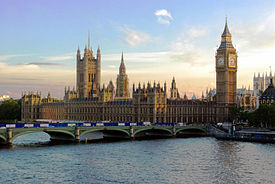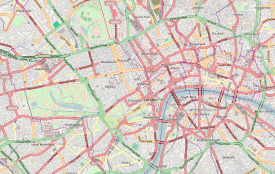
Back Paleis van Westminster Afrikaans قصر وستمنستر Arabic قصر وستمنستر ARZ Palaciu de Westminster AST Vestminster sarayı Azerbaijani Palasyo nin Westminster BCL Вэстмінстэрскі палац Byelorussian Ўэстмінстэрскі палац BE-X-OLD Уестминстърски дворец Bulgarian ওয়েস্টমিনস্টার প্রাসাদ Bengali/Bangla
| Palace of Westminster | |
|---|---|
 The Palace of Westminster with Elizabeth Tower and Westminster Bridge, viewed from across the River Thames | |
| Location | City of Westminster, London, England |
| Coordinates | 51°29′57″N 00°07′29″W / 51.49917°N 0.12472°W |
| Area | 112,476 m2 (1,210,680 sq ft) [1] (internal) |
| Built | 1016 |
| Demolished | 1834 (due to fire) |
| Rebuilt | 1840–70 |
| Architectural style(s) | Perpendicular Gothic Revival |
| Owner | King Charles III in right of the Crown[2] |
| Official name: Palace of Westminster, Westminster Abbey, and St Margaret's Church | |
| Type | Cultural |
| Criteria | i, ii, iv |
| Designated | 1987 (11th session) |
| Reference no. | 426 |
| Country | United Kingdom |
| Region | Europe |
| Extensions | 2008 |
Listed Building – Grade I | |
| Official name: Houses of Parliament / The Palace of Westminster | |
| Designated | 5 February 1970 |
| Reference no. | 1226284[3] |

The Palace of Westminster, also known as the Houses of Parliament or Westminster Palace, in London, is where the two Houses of the Parliament of the United Kingdom meet.
In 1605, Guy Fawkes attempted to blow the Palace up. He was caught and later executed. This was called the Gunpowder Plot, and is celebrated on 5 November every year.
The original building was used as a palace and home to the Parliament of England. After a fire in 1834, the building was used as a Parliament building.
Westminster Palace, Westminster Abbey and Saint Margaret's Church make up a UNESCO World Heritage Site.[4] Westminster Palace is an example of Gothic Revival architecture.[4]
The building is in bad shape. There have been falling stonework, 10 fires, and an incident of potential asbestos exposure since 2020. There are leaking pipes and a serious risk of fire. The water, electric, sewage and gas pipes need to be replaced. To do this work the politicians would have to move to somewhere else.[5]
- ↑ "Palace of Westminster: Factsheet" (PDF). Restoration and Renewal. Houses of Parliament. Archived from the original (PDF) on 14 September 2017. Retrieved 13 September 2017.
- ↑ Parliamentary Debates, House of Lords, 17 May 2006, "The Palace of Westminster is therefore Crown land because it is land in which there is a Crown interest, in this case an interest belonging to Her Majesty in right of the Crown.", column 339 "Archived copy". Archived from the original on 11 May 2021. Retrieved 29 January 2018.
{{cite web}}: CS1 maint: archived copy as title (link) CS1 maint: bot: original URL status unknown (link) - ↑ Historic England. "Details from listed building database (1226284)". National Heritage List for England (NHLE). Retrieved 9 July 2015.
- ↑ 4.0 4.1 UNESCO, "Westminster Palace, Westminster Abbey and Saint Margaret's Church"; retrieved 2012-4-21.
- ↑ Fisher, Lucy (2023-07-31). "MPs are stuck as UK parliament crumbles around them". Financial Times. Retrieved 2023-07-31.
